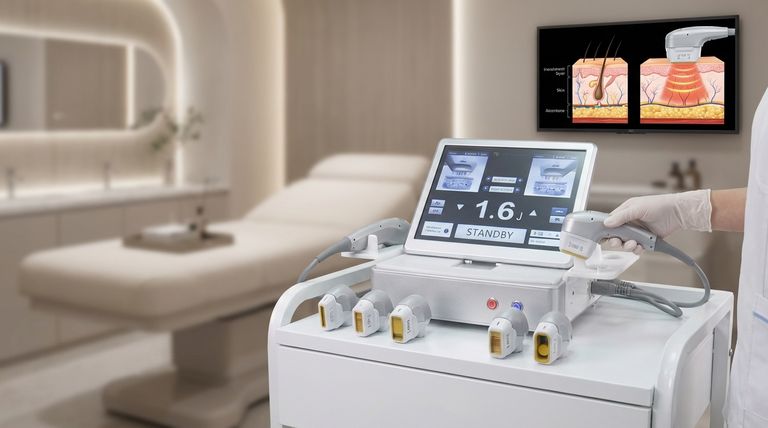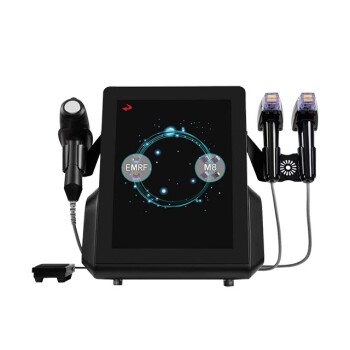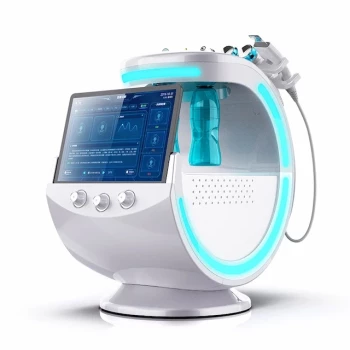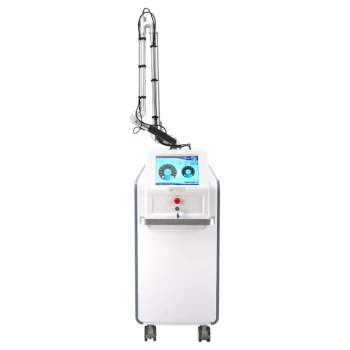There is no single "best" machine for skin tightening. The most effective device is the one whose technology is best matched to your specific type of skin laxity, your treatment goals, and your tolerance for downtime. The leading non-surgical options fall into categories like lasers, radiofrequency (RF) microneedling, and high-intensity ultrasound, all of which work by stimulating your body's natural collagen production.
The search for the "best" device is often misleading. The more important question is, "Which technology is right for my problem?" The key is to match the device's mechanism—how it delivers energy and at what depth—to your unique skin condition and desired outcome.

How Energy Devices Actually Tighten Skin
At its core, non-surgical skin tightening relies on a single biological principle: controlled thermal injury. By delivering a precise amount of energy (heat) to specific layers of the skin, these devices create a controlled "wound."
This process triggers the body's natural healing cascade. Your body responds by clearing out old, disorganized collagen and generating new, strong, and tightly organized collagen and elastin fibers. This renewal process is what leads to firmer, smoother, and visibly tighter skin over time.
A Breakdown of the Core Technologies
Different machines simply use different methods to deliver this targeted heat. Understanding these methods is the key to choosing the right treatment.
Ablative Lasers (CO2 & Erbium): The Resurfacing Powerhouses
These are the most powerful and aggressive options, including devices like Active FX, Deep FX, and Fraxel Repair. They work by vaporizing microscopic columns of skin tissue from the surface down into the dermis.
This intense resurfacing prompts a dramatic healing response, resulting in significant skin tightening and improvement in texture and deep wrinkles. While highly effective, they demand the most significant downtime, often involving a week or more of recovery.
RF Microneedling: The Dual-Action Solution
This category combines two effective treatments into one. Fine needles create micro-injuries in the skin, which itself stimulates collagen. Simultaneously, the tips of these needles deliver radiofrequency (RF) energy deep into the dermis.
This combination allows for deep, targeted heating and collagen remodeling without significant damage to the skin's surface. It is a highly effective and versatile treatment for tightening the face, neck, and body with more manageable downtime than ablative lasers.
High-Intensity Ultrasound: Targeting Deep Foundations
Devices like Sofwave use a novel parallel beam ultrasound technology. Instead of focusing on a single deep point, it creates a broad heating zone in the mid-dermis—the precise layer where collagen and elastin are most abundant.
This approach bypasses the skin's surface entirely, meaning there is zero downtime. It is an excellent choice for individuals with mild to moderate laxity who want a noticeable lift without any recovery period.
Micro-Coring: A New Mechanical Approach
The Ellacor system operates on a completely different principle. It is not an energy-based device. Instead, it uses hollow needles to physically remove thousands of microscopic "cores" of skin.
As the skin heals from these micro-excisions, it closes the gaps and naturally tightens. This is a specialized treatment primarily used to address moderate to severe wrinkles and laxity in the lower face, offering visible skin removal without the scarring of a traditional facelift.
Understanding the Critical Trade-offs
Choosing a treatment is a balance of risks and rewards. Being aware of the trade-offs is essential for managing your expectations.
Efficacy vs. Downtime
There is a direct and unavoidable correlation between the intensity of a treatment and the results it can achieve.
More aggressive treatments like ablative CO2 lasers produce the most dramatic tightening but require significant recovery. Gentler, no-downtime options like Sofwave offer real improvement but may require more sessions or produce subtler results.
The Importance of the Provider
A machine is only a tool; the results are dictated by the skill of the person operating it. An experienced, board-certified dermatologist or plastic surgeon will properly diagnose your specific type of laxity and select the appropriate device and settings for you.
Their expertise is far more critical to your outcome than the brand name of the machine itself.
Cumulative vs. "One-and-Done" Results
Some treatments, like CO2 lasers, are often performed as a single, powerful session. Others, such as RF microneedling or ultrasound, may deliver the best results over a series of two to three sessions spaced several weeks apart. Understand the recommended protocol for your chosen technology.
Making the Right Choice for Your Goal
To find your "best" machine, start with your primary objective.
- If your primary focus is dramatic results for significant laxity and wrinkles, and you can tolerate a week or more of downtime: An ablative laser like a CO2 (Active FX, Fraxel Repair) or Erbium is likely your most effective path.
- If your primary focus is significant tightening with moderate, manageable downtime: RF Microneedling is an excellent, well-rounded choice that effectively targets laxity on the face and neck.
- If your primary focus is preventing and treating mild to moderate laxity with absolutely no downtime: An ultrasound device like Sofwave is the ideal technology to consider.
- If your primary focus is addressing noticeable laxity and wrinkles specifically in the lower cheeks and jowl area: Discuss the unique mechanical approach of Micro-Coring (Ellacor) with a qualified provider.
Ultimately, the most effective treatment is one that is chosen with a deep understanding of your own goals, in consultation with a qualified provider you trust.
Summary Table:
| Technology | Best For | Downtime | Key Devices |
|---|---|---|---|
| Ablative Lasers (CO2/Erbium) | Dramatic results for significant laxity & wrinkles | High (1+ week) | Active FX, Fraxel Repair |
| RF Microneedling | Significant tightening on face & neck | Moderate | Various RF Microneedling Systems |
| High-Intensity Ultrasound | Mild to moderate laxity with zero downtime | None | Sofwave |
| Micro-Coring | Moderate to severe laxity in lower face | Minimal | Ellacor |
Ready to Find Your Perfect Skin Tightening Solution?
Choosing the right technology is the first step; partnering with the right provider is what ensures outstanding results. BELIS specializes in professional medical aesthetic equipment, serving medical aesthetics clinics and premium beauty salons.
We provide expert guidance and state-of-the-art devices to help you offer the most effective treatments to your clients. Let us help you enhance your service portfolio and grow your business.
Contact BELIS today to discuss how our skin tightening technologies can benefit your practice.
Visual Guide

Related Products
- 7D 12D 4D HIFU Machine Device
- 4D 12D HIFU Machine Device for Skin Tightening and Lifting
- 12D HIFU Machine Device for Facial HIFU Treatment
- 4D 12D HIFU Machine Device for Skin Tightening
- 22D HIFU Machine Device Facial Machine
People Also Ask
- What does HIFU do for your face? Achieve a Non-Surgical Facelift with Focused Ultrasound
- How long does it take for HIFU to show results? See the Dual-Phase Timeline for Natural Lifting
- How frequently should you do HIFU? Optimize Your Results with the Right Schedule
- What is the best frequency for HIFU treatment? Achieve Lasting Lifting & Tightening Results
- How do I maximize my HIFU results? A Guide to Optimal Lifting and Tightening



















